This post attempts to provide a comprehensive guide to treating seborrheic dermatitis on the chest. It begins with a general evaluation of the condition and then wraps things up with an evaluation of potential treatments (with corresponding opinions on each).
A summary is provided at the end of the article and if you have any additional questions or suggestions please drop them in the comments section below.
Quick Recap of the Condition
Seborrheic dermatitis is considered to be a chronic skin condition that affects 3-5% of the adult population. Though there are a variety of treatments for the reduction of symptoms, the consensus amongst the medical professionals is that there is no permanent cure.
Primary Symptoms of Seborrheic Dermatitis
The condition is characterized by irritated, inflamed, and itchy skin, covered by dry patches of skin flakes, and excessive sebum production. In some cases, excessive sebum production may be replaced with excessive dryness and cracking of the skin surface.
For the majority of cases, the condition can be easily diagnosed via visual inspection. However, there is a possibility of misdiagnosis as there are several other conditions which can present visually similar symptoms (such as psoriasis, rosacea, tinea faciei, and several others).
If you have been diagnosed with seborrheic dermatitis, but none of the common treatment approaches are working out, it’s a good clue that further diagnosis may be needed.
Areas Most Commonly Affected by Seborrheic Dermatitis
The condition is believed to a more aggressive form of dandruff that affects areas beyond the scalp. Excluding the scalp, specific facial regions are the most commonly affected areas. These include the nasolabial folds, forehead, chin, ears, and hairline.
In some individuals, the symptoms can spread further and appear below the neck. If you reading this, you most likely fall into this category.
What Connects These Areas
Now, you may be wondering, what is it that ties all these areas together and why your issues have spread beyond the usual places?
Well, what ties all these areas together is they are all areas which have an increased density of sebaceous glands (glands that our skin uses to produce and output sebum on to its surface). This increased density translates to more sebum and this is exactly what results in the specific areas being affected by the condition.
In essence:
More sebaceous glands -> more sebum production -> higher chance of seborrheic dermatitis symptoms
However, this does not mean that your skin issues are the simple result of excess sebum production. Some individuals have extremely high sebum production but are fortunate enough to be spared by seborrheic dermatitis. While others are forced to deal with the crummy symptoms the condition brings (even in the absence of excess sebum production).
Malassezia -> Oleic acid -> Symptoms
Now that you sebum plays a role in seborrheic dermatitis symptoms, let’s review what exactly occurs at the skin surface.
For the most part, the medical community has come to the consensus that the main culprit behind seborrheic dermatitis is not the sebum, but the malassezia yeasts which feed on it.
The malassezia yeasts are considered “commensal” microorganisms. This means, they are naturally present on the skin surface and typically present no threat to the host (individual whose skin they live on). But in the case of seborrheic dermatitis, these yeasts are believed to play a role in the progression of skin symptoms.
Though there is still a significant amount of uncertainty here, it appears that it’s not actually the yeasts themselves that trigger seborrheic dermatitis symptoms. Instead, research suggests that these by-products of the yeasts feeding cycle, namely oleic free fatty acids, are to blame.
Oleic free fatty acids are known irritants to the skin. They can break down the natural skin barrier and have been shown to trigger the same symptoms seen in seborrheic dermatitis individuals with normal skin (in the absence of malassezia yeasts).
As a result, it seems that isolating only the malassezia yeast is no longer a viable approach. Instead, we should realize the condition is likely a combination of three primary components [1]:
- Presence of malassezia yeast
- Individual sensitivity (to oleic free fatty acid and malassezia)
- Composition of the sebum
Taken together, these three factors are the most likely explanation for the condition we have today.
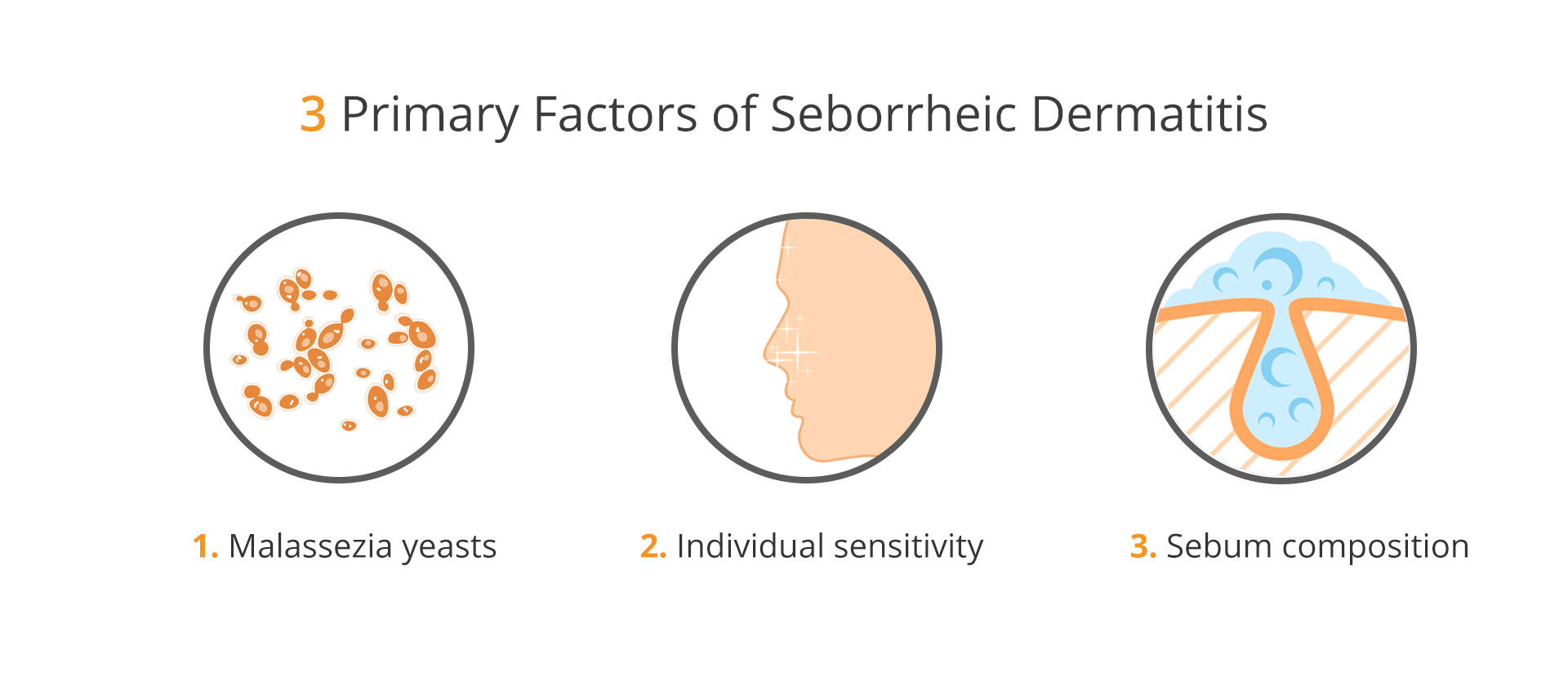
Possible Treatment Approaches to Seborrheic Dermatitis on the Chest
For the last part of this article, let’s examine some of the main ways you can treat chest seborrheic dermatitis.
Taking the Straightforward Anti-Fungal Approach
The primary seborrheic dermatitis treatment approach utilized by dermatologists and researchers is the use of anti-fungal agents. This approach has been used for several decades and helped establish a significant portion of the state of knowledge on the condition.
Anti-fungal agents aim to suppress malassezia activity and curb its reproduction rate. This suppression leads to reduced production of oleic free fatty acids at the skin surface and is usually accompanied by a clearance of the majority of symptoms.
In North America, the most commonly used antifungals for the treatment of seborrheic dermatitis are:
- Zinc pyrithione
- Clotrimazole
- Ketoconazole
- Selenium sulfide
If you interested in the details of how each on work and their safety profile, you find additional in-depth review of these agents in the section of the online eBook.
Overall, the success rate of anti-fungal treatments is high, but room for improvement remains (some side-effects exist and they are not always effective). If your dealing seborrheic dermatitis, antifungals should be a good starting point.
My personal experience with anti-fungal treatments
On paper, antifungals are very appealing. For me, they usually yielded quick improvement but lacked long-term effectiveness (results gradually declined with ongoing usage).
Accordingly, a variety of products exists that utilize the approved antifungals and these products are the most popular way the majority of individuals deal with their issues.
Anti-fungal treatments can be broken down into 2 primary categories:
- Anti-fungal soaps and shampoo
- Anti-fungal creams and ointments
And each has their own benefits and drawbacks.
Soaps and shampoos are applied for a short duration and washed off. No residue is left on the skin and they can be easily incorporated into your existing regimen. Since the skin is only exposed to the active agent for a short period of time, the anti-fungal potential is hindered, but at the same time, the chance of irritation may be reduced.
Creams and ointments, on the other hand, are designed to be applied for a longer duration and more gradual absorption into the skin. Though a lower concentration of anti-fungal agent is usually used, the longer time in contact with the skin surface allows the anti-fungal remain present for a longer duration. Again, this can be both helpful (in terms of malassezia inhibition), but may also increase the chance of unwanted side-effects.
Using Anti-Fungal Shampoos on the Chest
When using an anti-fungal shampoo on the chest the following approach is most common:
- Dispense a dab of shampoo into the palm of one hand and lather with the help of your other hand
- Apply the lather on to the affected area of your chest
- Wait 3-5 minutes, allowing the anti-fungal agent to do its work
- Rinse off and gently dry with a clean towel
As symptoms improve, you may be able to reduce the amount of time the shampoo needs to stay in contact with the affected skin.
Read the instruction
Some specific antifungals may be more aggressive. Thus, it’s important to read the specific instructions on the bottle/packaging of the specific product you’re using.
Most Popular Antifungal Shampoos for Treatment of Seborrheic Dermatitis on the Chest
This is a list of the most popular shampoos by active anti-fungal ingredient in the North American market (in the format of “brand name – active ingredient”):
- Head and Shoulders – Zinc Pyrithione
This is probably the most popular and well recognized anti-dandruff shampoo around the world. - Nizoral – Ketoconazole
Ketoconazole is considered to have strong inhibition activity against the malassezia yeast. From my experience, Nizoral can be more drying to the skin then Head and Shoulders. In some countries, a prescription may be required. - Selsun Blue – Selenium Sulfide
There is a subset of users who have reported that selenium sulfide can work in cases where others have failed. However, the literature suggests that ketoconazole and zinc pyrithione can have higher clearance rates and a reduced chance of side effects. Haven’t personally tried this one, so can’t really comment on it. - Jason’s Naturals – Sulfur and Salicylic Acid
Sulfur may be one of the oldest antifungals used for the treatment of dandruff and seborrheic dermatitis [2]. Though it’s effectiveness has been reported to be marginally lower than the newer anti-fungal agents and it gives off a strong odor, it’s natural origin and long history can make it an appealing candidate. - Neutrogena T/Gel – Coal Tar
Coal tar is another antifungal agent of natural origin with a long history of usage. The strong odor and color can make it less appealing for scalp and facial usage, but for chest usage where these aspects are less important, it may be a great option. For me, it was my favorite anti-fungal shampoo.
For the most part, many of these shampoos are available at your local supermarket and are fairly inexpensive. You can find additional details on each of them in a previous post that covers 7 of the most popular seborrheic dermatitis shampoos
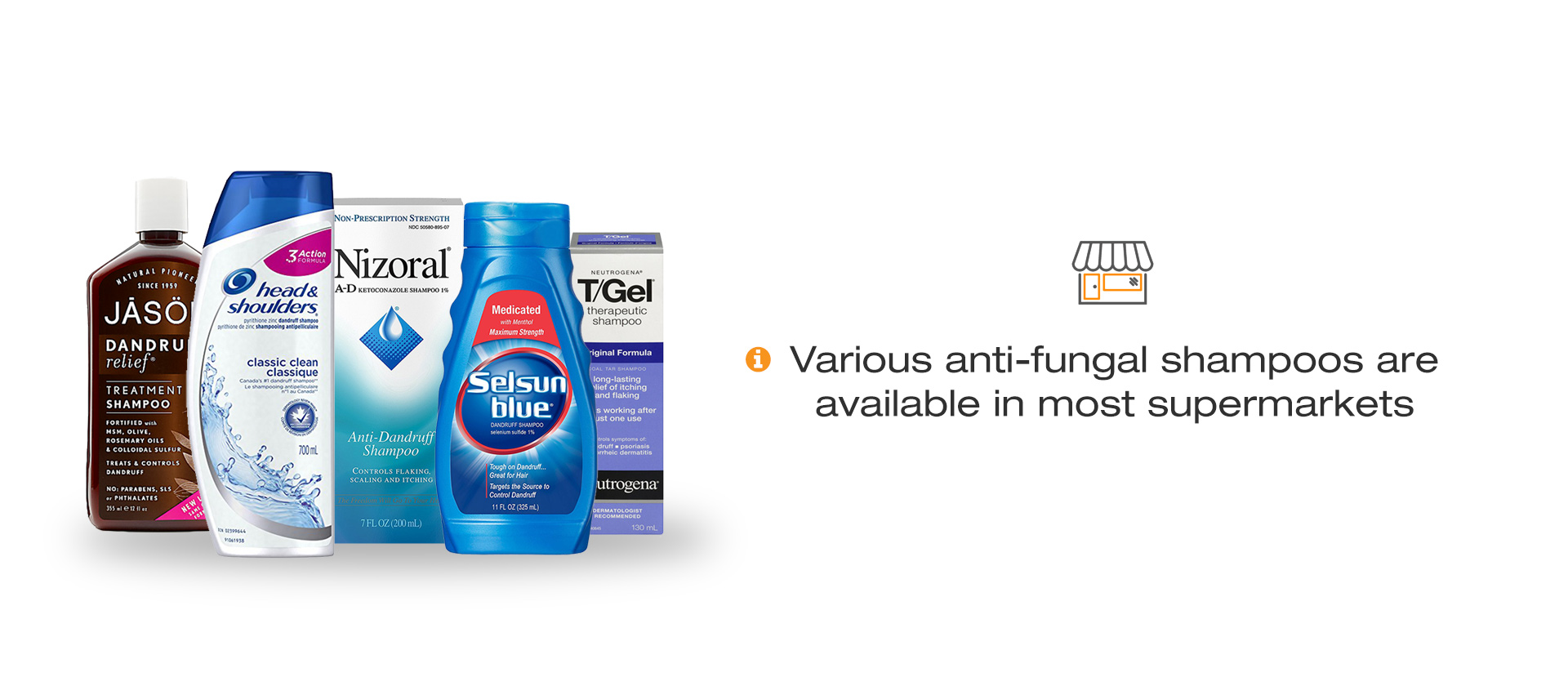
Using Anti-Fungal Creams on the Chest
There really isn’t much to be said in terms of using a cream on the chest as it’s a fairly straightforward endeavor. Simply apply the cream on the affected area and massage into the skin. That’s it.
One thing to keep in mind though is that since creams usually use a lower concentration of the active anti-fungal agent, it’s a good idea to make sure you’re not accidentally removing the skin with your clothing. To help offset this, applying the cream 5-10 minutes before covering the area with clothing can help ensure the cream has enough time to absorb.
Most Popular Antifungal Seborrheic Dermatitis Creams for Chest Treatment
Now when it comes to anti-fungal creams your options become somewhat more limited and they usually have to be purchased online. In some cases, a prescription is needed, but these won’t be included here (consulting with a local dermatologist is recommended).
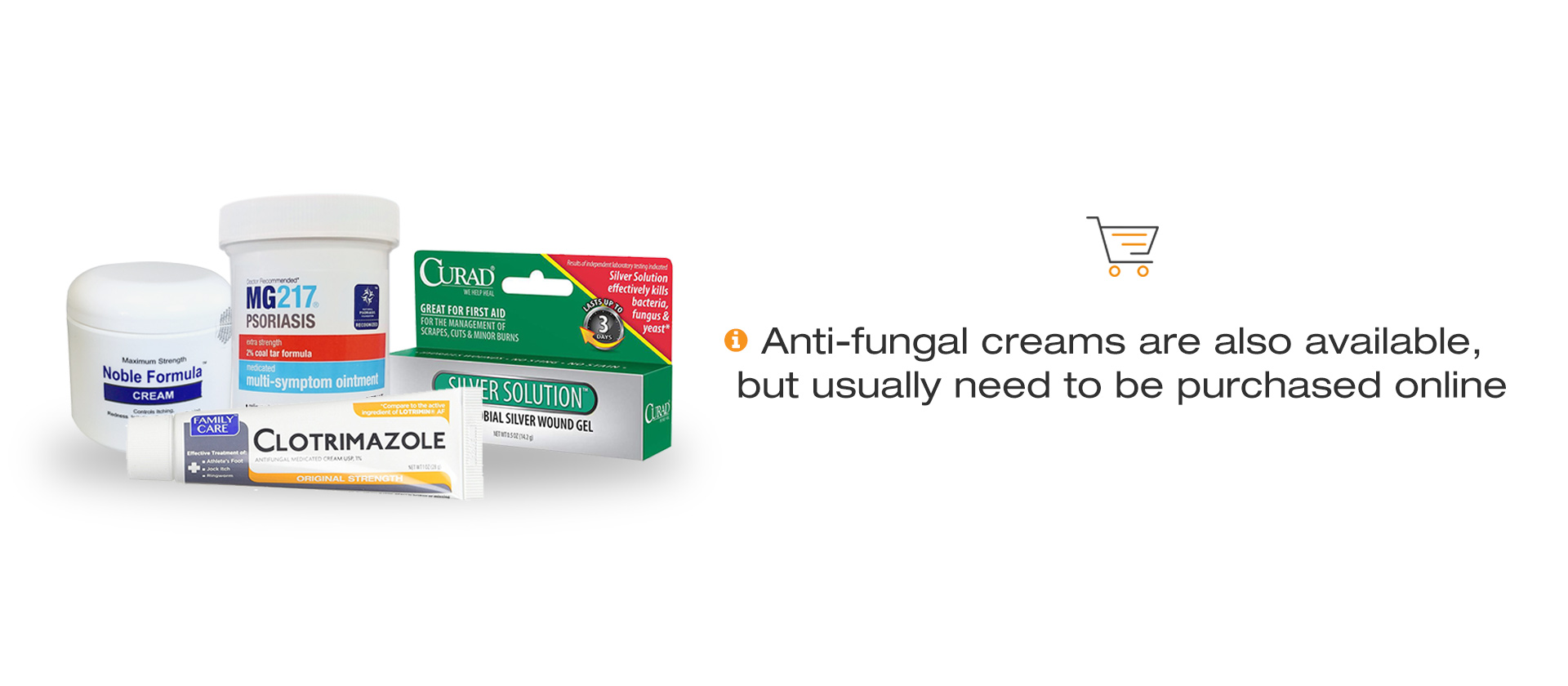
Some viable options that I’ve come across include:
- Noble Formula’s – Zinc Pyrithione
- Curad Silver Solution Antimicrobial Gel
- MG217 Psoriasis Treatment 2% Coal Tar Ointment
- Family Care Clotrimazole Anti-Fungal Cream
- Generic Nystatin Cream
A more thorough discussion of each of these can be found in a previous article found here: Finding the Best Seborrheic Dermatitis Cream.
Repairing a Damaged Skin Barrier and Reducing Irritation
Another often overlooked aspect of seborrheic dermatitis is the damaged skin barrier which is technically the primary source of the symptoms you experience. In theory, if the skin barrier was stable and healthy, the irritants on the skin surface would be unable to interact with the lower layers of the skin and your symptoms would be greatly reduced.
Some ways you can improve skin barrier function include:
- Barrier repair creams and ointments
Though barrier repair creams are usually designed with eczema and atopic dermatitis in-mind, they may also hold significant potential for the treatment of seborrheic dermatitis. Since they can be quite costly, asking your local pharmacy if they have any samples available can be an economical way to see if this approach is right for you. - Avoidance of regular soap and strong surfactants (cleaning agents)
Soap and many common skin/scalp cleaners can cause significant barrier disruption and irritation. By limiting their usage and seeking products designed for sensitive skin, you increase your chances for long-term success. - Washing the area with cold water
If you look around online, there are numerous reports that reducing the water temperature of your showers can go along way to keeping seborrheic dermatitis symptoms at bay. When I examined why this may be the case, I discovered that lower temperature can help reduce irritation caused by commonly used surfactants. Thus, if your using an anti-fungal shampoo on your chest, washing with cold water only may further improve the chances of a positive outcome.
And these have been covered in more significant in other sections of this website.
If you see progress from these approaches, you can find more ideas in these two SkinSupport sections:
They include the above in-depth discussion of the three approaches mentioned above, but also go introduce several novel ideas.
Natural Treatment Options
The demand for natural treatment approaches to seborrheic dermatitis continues to increase. Whether this is due to the recent emergence of antibiotic-resistant microbes or simply a general shift in the perception of opinions, almost anyone can agree that an effective natural treatment would be preferred to its synthetic alternative.
Unfortunately, for the most part, natural treatment approaches are not as actively researched and examined as synthetic agents. The reason is that the incentive to invest into widely available and virtually unprotectable (by patents) simply does not make financial sense. In the modern world, money often dictates the direction of research and thus, out views and opinions may be several skewed [3, 4].
Nonetheless, even with the limited data available, many readers affected by seborrheic dermatitis may find significant relief from several natural approaches.
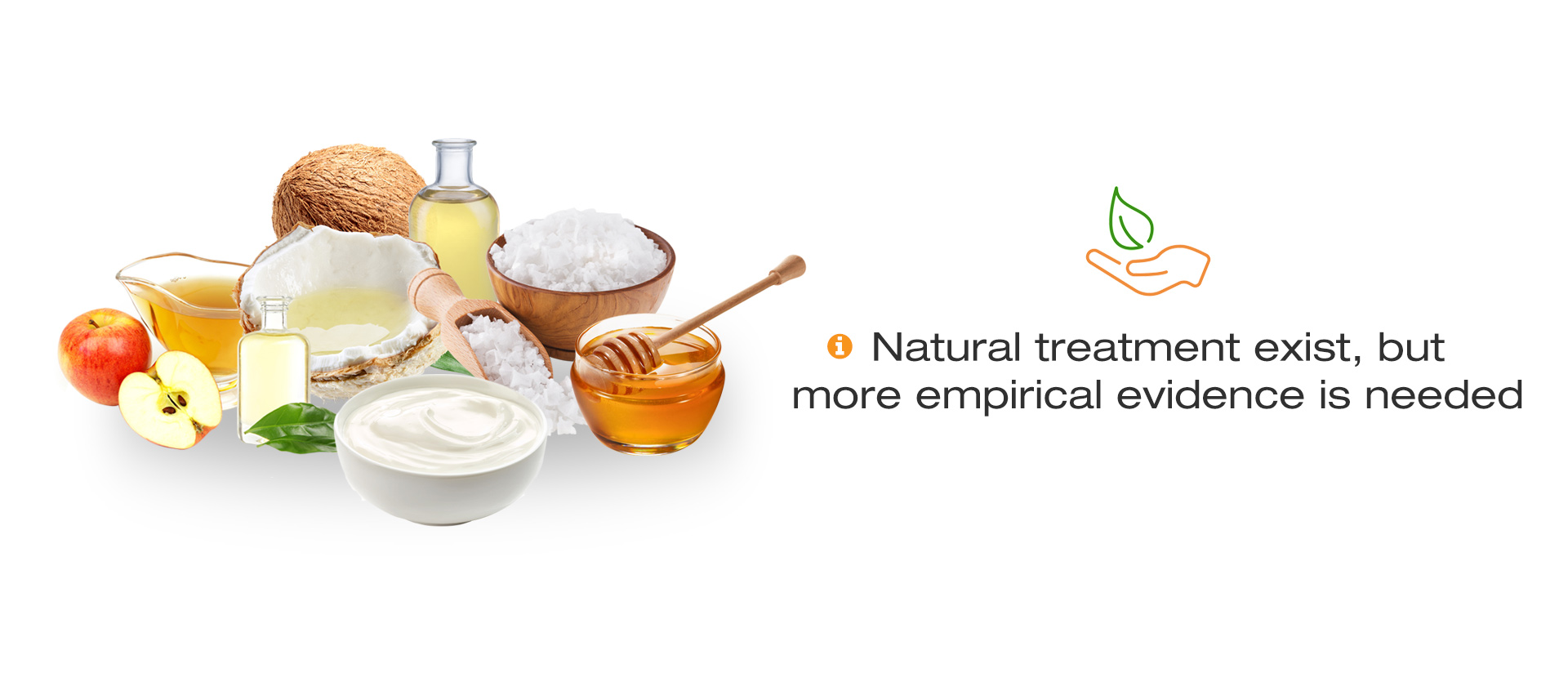
These are approaches are briefly described below (when available, each bullet is linked to previous more in-depth articles):
- Tea Tree Oil
Tea tree oil has documented anti-fungal properties and has been shown to inhibit malassezia yeasts. Studies examining its effectiveness as part of a shampoo formula have also demonstrated good potential and various tea tree oil-containing products are available. Alternatively, it can be purchased in its pure form and diluted accordingly. - Apple Cider Vinegar
Malassezia yeasts prefer a neutral pH and an overly acidic environment has been shown to be inhibitory to their production [5]. Though online sources typically suggest that apple cider vinegar has unique properties that make it unique in its ability to treat seborrheic dermatitis and other similar skin issues, the science suggests that almost any vinegar may prove sufficient [6]. - Raw Honey
Honey has a long history of use for various skin disorders [7, 8] and has been shown to have significant potential specifically for seborrheic dermatitis treatment [9]. Chest application may be a little tricky due to the stickiness and extended duration required for treatment, but those you persevere may be rewarded in the long term. - Dead Sea Salt
High in magnesium salts, dead sea salt has been shown to increase levels of skin hydration, improve barrier function, and reduce inflammation [10]. Taken together these beneficial properties can be helpful for not only seborrheic dermatitis but many other skin conditions involved inflammation and barrier disruption. It’s quick absorption rate and lack of left of residue make it a great candidate for usage on the chest. - Yoghurt
Some only reports suggest that topical application of yogurt can help relieve seborrheic dermatitis. Though there are no studies or papers confirming its effectiveness, some general preliminary studies suggest that the lactic acid content of yogurt may be useful for improving barrier function and improving wound repair [11]. Whatever the case may be, applying liberal amounts of yogurt to the chest does not seem to be a very appealing treatment approach. - Coconut Oil
Due to its low levels of oleic acid, coconut oil may be a good candidate for an all natural occlusive for individuals prone to seborrheic dermatitis symptoms. Though on it’s own it may not prove sufficient to control symptoms altogether and there are no studies confirming its effectiveness, it may be a great addition to another treatment.
As always, this list is not all-inclusive and there are other potential natural treatments not mentioned (baking soda, iodine, etc.). From my personal experience, the first 3 treatment mentioned above are some of the most effective of the natural approaches.
Thinking Outside the Realm of Topical Treatments
Since the root cause of seborrheic dermatitis is still not fully determined, many individuals (including myself) have sought more systemic approaches to controlling our symptoms.
This includes:
- Dietary elimination and/or modification
- Supplements
- Meditation and relaxation techniques
- Sebum suppression medicine (retinoids)
- Anti-inflammatory agents
Just to name a few.
The effectiveness of these approaches can be extremely hard to predict and is unique/specific to each individual. To keep this article readable and concise, going over these various approaches does not make much sense.
Instead, if this area is of interest to you, you may find the online eBook and dedicated SkinSupport sections of the website relavent.
What Makes Chest Treatment Unique
Seborrheic dermatitis on the chest is unique due to the specific characteristics of the skin in this area:
- Constant contact with clothing
The constant rubbing may increase irritation and aggravate sensitive skin. Wearing soft cotton and ensuring your clothing is clean can help reduce these aspects. - Increased local skin temperature
Since the skin is covered up, it’s more likely to have an increase in skin temperature (in comparison to the facial skin). Increased temperature has been theorized to be a component of seborrheic dermatitis progression. Though it can be hard to control this factor, it’s good to keep it in mind. - Reduced UV exposure (compared to the facial skin)
Natural sunlight has been shown to be beneficial in a variety of skin disorders (including psoriasis and seborrheic dermatitis). Exposing the chest to a bit of sunlight here and there may help with progress. On the flip side, when the skin barrier is damaged, sunlight can also exacerbate existing symptoms. - The presence of chest hair
In the past, shaving of the scalp has been used to help with aggressive cases of seborrheic dermatitis [12]. If your chest is full of hair, it may be worthwhile to consider shaving or waxing.
Apart from that, the other treatment principles are the same as treatment of seborrheic dermatitis on other areas of the body.
A General Treatment Framework for Seborrheic Dermatitis
After spending several years of my life researching seborrheic dermatitis and trying to find an optimal treatment approach, it has become apparent that there is not one fit’s all solution. A treatment that works for one person, may not work for another.
What does remain fairly consistent, are three core principles for practically any successful treatment regimen. These are:
- Ensure you have a correct diagnosis and are in-fact dealing with seborrheic dermatitis
- Find a suitable anti-fungal that does not irritate your skin and reduces the thick scale build-up
- Continue to work on improving barrier function with the help of topicals, diet, stress management, immune system enhancement, and environmental modification
And by following this framework, I believe the majority of individual faced with seborrheic dermatitis can obtain prolonged remission and gradually behind to forget about the condition altogether.
Summary
This article was my attempt to provide a blueprint for the treatment of seborrheic dermatitis on the chest. The discussion started with a general overview of the condition, discussed the unique characteristics of the skin found on your chest, and reviewed possible treatment options.
Key points include:
- Seborrheic dermatitis is a condition typically characterized by irritation, inflammation, itch, skin flakes, dryness, and excessive sebum production (some symptoms are not always present)
- The condition primarily affects sebum (oily skin secretions) rich area of the skin and in some individuals, this includes the chest area
- Malassezia yeasts, naturally present on the skin surface, consume this sebum and leave behind oleic free fatty acids which are known to irritate the skin and produce the symptoms we know as seborrheic dermatitis
- The most popular approach to treatment is with the use of anti-fungal agents which inhibit the malassezia yeasts; in North America zinc pyrithione, clotrimazole, ketoconazole, and selenium sulfide are most commonly used
- These anti-fungal agents can be found in a variety of over the counter creams and shampoos; for the chest, creams are likely to produce more significant results, but simple shampooing of the area may prove sufficient
- Focusing on repair and maintenance of the skin’s own protective barrier may be an alternate approach to treatment that deserves more attention and may lead to significant symptom relief without the use of anti-fungal agents
- Dedicated barrier repair creams, reduced skin cleansing frequency, avoidance of known irritants and soaps, specific washing habits, are all possible tactics to improve skin barrier function
- Natural treatment approaches don’t have much research that supports them, but some highly regarded approaches include apple cider vinegar, raw honey, dead sea salt, yogurt, and coconut oil
- The chest has certain features such as constant contact with clothing, increased skin temperature, reduced UV exposure, and the presence of chest hair, that need to be considered when approaching treatment
If you’ve made it this far, I’m guessing that your either very thorough with your reading or you’re growing tired of seborrheic dermatitis on your chest. Hopefully, the ideas and topics introduced in this article prove useful for you and your skin begins to heal. If you have any questions, suggestions, or treatment tips that you would like to share, feel free to drop them in the comments section below.
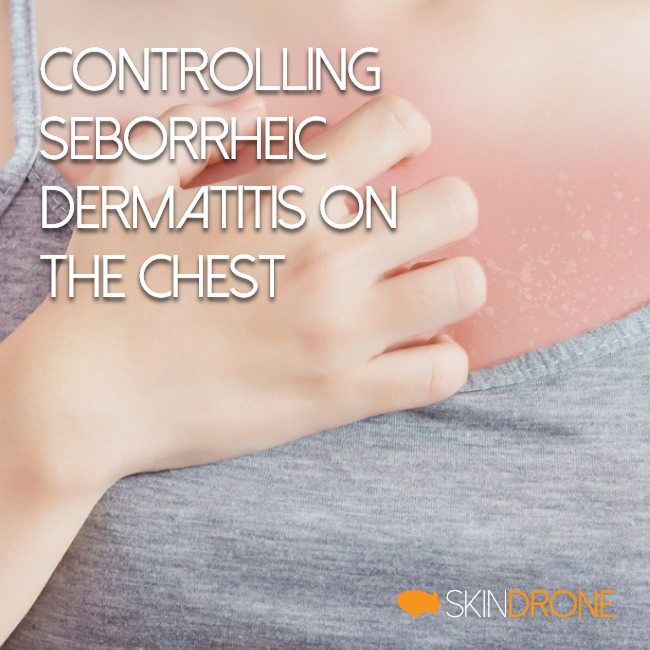

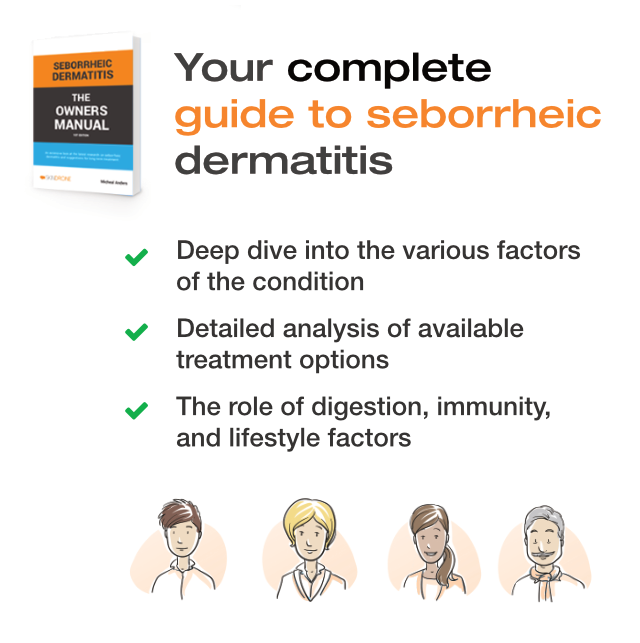
TMI
Your article has put it all together for me. The second article in my mini research bump but I understand this so much better now. The last 2 years I’ve had the rash that started in my elbow and spread to my chest and now down my legs and up my neck. I think it’s super impressive, medically, but it’s sometimes red, sometimes lighter, sometimes flaky, sometime not. I approached my PC about it last year and he told me to wash and it would go away…well here I am. Being in EMS, I knew it had to be somewhere in the dermatitis realm. But reading your article help me put it together. I had cradles cap as a baby, which my mom controlled with Meleluca, which turned into regular dandruff and it must have just evolved as I was at college. Ironically I know two other people who have it either as bad as me or now and again flare ups, and seldom blue was recommended to me. I wouldnt say I’ve been too persistent with it but honestly it didnt seem to do much, nor did it stop it from progressing down my legs. It’s all it seems most prevalent in areas where I sweat a lot, and it its and burns when I do sweat. Rubbing alcohol seemed to help but I know I’m not doing my skin much good, as you said. So now I’m going to try head and shoulders and maybe go back to meleluca. Otherwise I’m going to see a dermatologist. But thank you so much! I put a TMI warning because…well I’m spilling everything, but im just very happy I found the information and it was so well done!